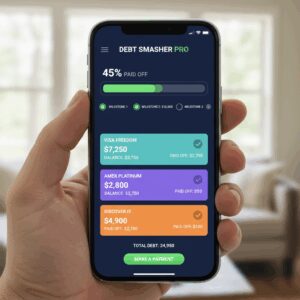
If March rolls around and your bank account mysteriously dips into survival mode—again—you’re not alone. Every year, just as we recover from the holiday spending hangover and vow to “get our finances right,” tax season delivers its signature blow.
But here’s the part no one tells you: it’s not the taxes themselves that drain you. It’s how you ignore the cycle—year after year—and fail to prepare for it like the predictable financial season it is.
Let’s break it down and talk about how to get off this roller coaster for good.
The Real Reason March Feels Like a Financial Crisis
There are two key factors:
- Delayed Income Catch-Up
January is usually a slow income month for freelancers, contractors, and small business owners. People are returning from holidays, budgets are frozen, and new contracts are pending. By the time February rolls in, you’re just starting to catch up. Then boom—taxes hit. - Quarterly Tax Estimates? What Quarterly Tax Estimates?
If you’re self-employed, you’re supposed to pay quarterly taxes. But most people don’t—or they underpay—because those chunks feel huge when business is inconsistent. Instead, they wait until April and pay one massive bill… with money they didn’t set aside.
What the Tax Cycle Actually Looks Like
Let’s stop pretending tax season is a one-time event. It’s a cycle. And when you’re self-employed or earning 1099 income, you live in that cycle. Here’s what it looks like in reality:
- Q1 (Jan–Mar): You’re recovering from slow income months and possibly haven’t saved anything for last year’s tax bill.
- Q2 (Apr–Jun): Tax Day arrives. You scramble to pay it—maybe with a credit card or a payment plan.
- Q3 (Jul–Sep): You start to catch up financially but are now haunted by that tax debt.
- Q4 (Oct–Dec): Holidays hit. Spending spikes. Savings vanish. Rinse and repeat.
Sound familiar?
The Fix: Tax Planning Like a Boss
If you’re trying to break the March-broke cycle, it’s not about having more money—it’s about having a better system. Here’s how to do it:
1. Start With Your Real Income
Know your gross AND net income. If you made $60,000 as a freelancer last year, you didn’t really make $60K. Between taxes, software, supplies, and expenses, your net might’ve been closer to $45K. Start planning with that number in mind.
2. Pay Yourself Weekly and Tax Yourself Weekly
Open a separate bank account labeled “Taxes.” Every time you pay yourself, transfer 25–30% of that amount into the tax account. Out of sight, out of touch, but not out of reach.
3. Automate Quarterly Reminders
Set up Google Calendar alerts a week before each quarterly estimated tax due date (January 15, April 15, June 15, September 15). Even if you’re not sending a full payment, this keeps taxes top of mind and breaks the once-a-year panic cycle.
4. Create a “March Buffer”
Just like you save for December gifts, create a buffer for March. Call it what you want—Tax Cushion, IRS Fund, Anti-Broke Fund. Start in October. Put away $100 a week. By March, you’ll have over $1,200—enough to at least soften the blow.
Long-Term Strategy: Talk to a Pro
No, TurboTax is not your tax strategy. And no, that one friend who “does their own taxes every year” isn’t a substitute for professional advice. If you have 1099 income, run a small business, or juggle multiple revenue streams, get a tax professional. They can help you:
- Reduce your taxable income legally
- Set up proper deductions
- Avoid underpayment penalties
- Plan ahead instead of playing catch-up
Financial Seasons Are Predictable—Plan Accordingly
March doesn’t have to be your financial villain every year. If anything, it’s a reflection of how well (or poorly) you planned the previous 12 months. Getting ahead of tax cycles isn’t just about taxes—it’s about peace of mind, confidence, and finally feeling like you’re in control of your money.
So next time March shows up, let it find you ready—not broke.
Unlock Full Article
Watch a quick video to get instant access.









